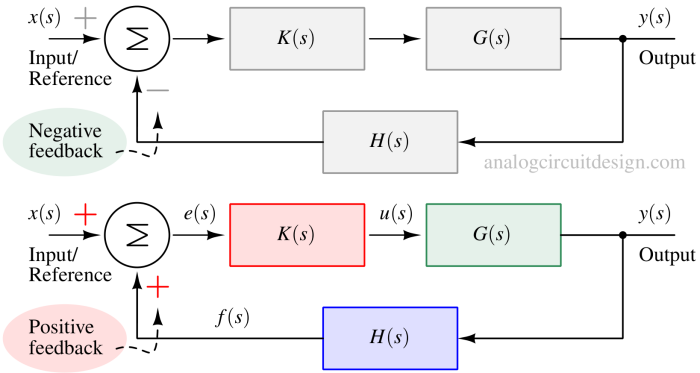Positive feedback system
What is a positive feedback system?¶
A positive feedback system within a system is characterized by an amplification of the initial change or deviation from a desired set point, rather than a correction. In simple terms, it magnifies the departure from the typical or desired state, potentially leading to exponential growth or an uncontrollable chain reaction.
Block diagram of a positive feedback system¶
In Fig 1, a comparison between negative and positive feedback circuits is made. The crucial difference is the sign of the summer where the sign is negative for the negative feedback circuit and the sign in positive for the positive feedback circuit.

Mathematically, we can distinguish the positive and negative feedback signal by finding the loop gain. If we break the loop from e(s) and put x(s)=0 we can write the loop gain of the negative feedback circuit to be :
$$LG(s)=-K(s)G(s)H(s)$$
Similarly, we can write the loop gain for a positive feedback system to be :
$$LG(s)=+K(s)G(s)H(s)$$
If we assume that the K(s)G(s)H(s) is a positive valued function, we can say that the loop gain of the negative feedback system is negative while the loop gain for the positive feedback system is positive.
Transfer function of a positive feedback system¶
To find the transfer function y(s)/x(s) of the above system, we shall list the simple relations below:
$$e(s)=x(s)+f(s)$$
$$u(s)=e(s)\cdot{}K(s)$$
$$y(s)=u(s)\cdot{}G(s)$$
$$f(s)=y(s)\cdot{}H(s)$$
After solving the above equations, we can find the transfer function :
$$\implies{}\cfrac{y(s)}{x(s)}=\cfrac{K(s)G(s)}{1-K(s)G(s)H(s)}$$
Examples and application of positive feedback¶
- Amplification: Positive feedback is used in electronic amplifiers to increase the amplitude of signals, such as in audio amplifiers and RF (radio frequency) amplifiers.
- Oscillators: Positive feedback is essential in creating oscillations in electronic circuits, making it a fundamental component of signal generators, radio transmitters, and clock generators.
- Thermal Runaway in BJT: Positive feedback can be seen in BJT at high power levels. At high power, the temperature increases, and this increase in temperature causes the current to increase further causing more power and subsequent temperature rise.
- Laser Technology: In lasers, positive feedback is utilized to stimulate the emission of coherent light, allowing for applications in cutting, welding, and telecommunications.
- Comparator or latch: Positive feedback is used in electronic comparators and latches to reach the steady state faster than open loop circuits.